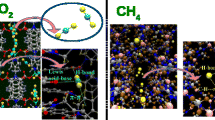Abstract
MCM-41 and buckytubes are novel porous materials with controllable pore sizes and narrow pore size distributions. Buckytubes are carbon tubes with internal diameters in the range 1–5 urn. The structure of each tube is thought to be similar to one or more graphite sheets rolled up in a helical manner. MCM-41 is one member of a new family of highly uniform mesoporous silicate materials produced by Mobil, whose pore size can be accurately controlled in the range 1.5–10 nm. We present grand canonical Monte Carlo (GCMC) simulations of single fluid and binary mixture adsorption in a model buckytube, and nonlocal density functional theory (DFT) calculations of trace pollutant separation in a range of buckytubes and MCM-41 pores. Three adsorbed fluids are considered; methane, nitrogen and propane. The GCMC studies show that the more strongly adsorbed pure fluid is adsorbed preferentially from an equimolar binary mixture. Ideal adsorbed solution theory (IAST) is shown to give good qualitative agreement with GCMC when predicting binary mixture separations. The DFT results demonstrate the very large increases in trace pollutant separation that can be achieved by tuning the pore size, structure, temperature and pressure of the MCM-41 and buckytube adsorbent systems to their optimal values.
Similar content being viewed by others
References
Ajayan, P.M. and S. Iijima, “Capillarity-Induced Filling of Carbon Nanotubes,” Nature, 361, 333–334 (1993).
Ajayan, P.M., O. Stephan, C. Colliex, and D. Trauth, “Aligned Carbon Nanotube Arrays Formed by Cutting a Polymer Resin-Nanotube Composite,” Science, 265, 1212–1214 (1994).
Allen, M.P. and D.J. Tildesley, Computer Simulation of Liquids, Chapter 4, Clarendon Press, Oxford, 1987.
Beck, J.S., J.C. Vartuli, W.J. Roth, M.E. Leonowicz, C.T. Kresge, K.D. Schmitt, C.T.-W. Chu, D.H. Olson, E.W. Sheppard, S.B. McCullen, J.B. Higgins, and J.L. Schlenker, “A New Family of Mesoporous Molecular Sieves Prepared with Liquid Crystal Templates,” J. Am. Chem. Soc., 114, 10834–10843 (1992).
Bethune, D.S., C.H. Kiang, M.S. deVries, G. Gorman, R. Savoy, J. Vasquez, and R. Beyers, “Cobalt-Catalyzed Growth of Carbon Nanotubes with Single-Atomic-Layer Walls,” Nature, 363, 605–607 (1993).
Bezus, A.G., A.V. Kiselev, A.A. Lopatkin, and Pham Quang Du, “Molecular Statistical Calculation of the Thermodynamic Adsorption Characteristics of Zeolites using the Atom-Atom Approximation. Part 1-Adsorption of Methane by Zeolite NaX,” J. Chem. Soc. Faraday Trans., 74, 367–379 (1978).
Branton, P.J., P.G. Hall, and K.S.W. Sing, “Physisorption of Nitrogen and Oxygen by MCM-41, a Model Mesoporous Adsorbent,” J. Chem. Soc. Chem. Commun., 1257–1258 (1993).
Ebbesen, T.W., P.M. Ajayan, H. Hiuri, and K. Tanigaki, “Purification of Nanotubes,” Nature, 367, 519 (1994).
Evans, R., Inhomogeneous Fluids, D. Henderson (Ed.), Dekker, New York, 1992.
Feuston, B.P. and J.B. Higgins, “Model Structures for MCM-41 Materials: A Molecular Dynamics Simulation,” J. Phys. Chem., 98, 4459–4462 (1994).
Franke, O., G. Schulz-Ekloff, J. Rathousky, J. Starek, and A. Zukal, “Unusual Type of Adsorption Isotherm describing Capillary Condensation without Hysteresis,” J. Chem Soc. Chem. Commun., 724–726 (1993).
Ge, M. and K. Sattler, “Vapor-Condensation Generation and STM Analysis of Fullerene Tubes,” Science, 260, 515–518 (1993).
Hirschfelder, J.O., C.F. Curtiss, and R.B. Bird, Molecular Theory of Gases and Liquids, 2nd Edition, J. Wiley and Sons, New York, 1964.
Howard, J.B., K.D. Chowdry, and J.B. Vander Sande, “Carbon Shells in Flames,” Nature, 370, 603 (1994).
Iijima, S., “Helical Micrombules of Graphitic Carbon,” Nature, 354, 56–58 (1991).
Iijima, S. and T. Ichihashi, “Single-Shell Carbon Nanotubes of 1-nm Diameter,” Nature, 363, 603–605 (1993).
Kierlik, E. and M.L. Rosinberg, “Density-Functional Theory for Inhomogeneous Solids: Adsorption of Binary Mixtures,” Phys. Rev. A, 44, 5025–5037 (1991).
Kresge, C.T., M.E. Leonowicz, W.J. Roth, J.C. Vartuli, and J.S. Beck, “Ordered Mesoporous Molecular Sieves Synthesized by a Liquid-Crystal Template Mechanism,” Nature, 359, 710–712 (1992).
Maddox, M.W. and K.E. Gubbins, “Molecular Simulation of Fluid Adsorption in Buckytubes and MCM-41,” Int. J. Thermophysics, 15, 1115–1123 (1994).
Maddox, M.W. and K.E. Gubbins, “Molecular Simulation of Fluid Adsorption in Buckytubes,” Langmuir, 11, 3988–3996 (1995).
Martin, C.R., “Nanomaterials: A Membrane-Based Synthetic Approach,” Science, 266, 1961–1966 (1994).
Myers, A.L. and J.M. Prausnitz, “Thermodynamics of Mixed-Gas Adsorption,” A.I.Ch.E. Journal, 11, 121–127 (1965).
Percus, J., “Free Energy Models for Nonuniform Classical Fluids,” J. Stat. Phys., 52, 1157–1178 (1988).
Rosenfeld, Y., “Free-Energy Model for the Inhomogeneous Hard-Sphere Fluid: “Closure” relation between Generating Functionals for “Direct” and “Cavity” Distribution Functions,” J. Chem. Phys., 93, 4305–4311 (1990).
Sing, K.S.W., D.H. Everett, R.A.W. Haul, L. Moscou, R.A. Pierotti, J. Roquerol and T. Siemeneiewska, “Reporting Physisorption Data for Gas/Solid Systems,” Pure Appl. Chem., 57, 603–619 (1985).
Sowers, S.L. and K.E. Gubbins, “Selective Removal of Trace Pollutants in Gaseous Streams by Adsorption in Micropores,” submitted to Langmuir (1995).
Steele, W.A., The Interaction of Gases with Solid Surfaces, Pergamon, Oxford, 1974.
Tsang, S.C., P.J.F. Harris, and M.L.H. Green, “Thinning and Opening of Carbon Nanotubes by Oxidation Using Carbon Dioxide,” Nature, 362, 520–522 (1993).
Tsang, S.C., Y.K. Chen, P.J.F. Harris, and M.L.H. Green, “A Simple Chemical Method for Opening and Filling Carbon Nanotubes,” Nature, 372, 159–162 (1994).
Author information
Authors and Affiliations
Rights and permissions
About this article
Cite this article
Maddox, M.W., Sowers, S.L. & Gubbins, K.E. Molecular simulation of binary mixture adsorption in buckytubes and MCM-41. Adsorption 2, 23–32 (1996). https://doi.org/10.1007/BF00127095
Issue Date:
DOI: https://doi.org/10.1007/BF00127095




